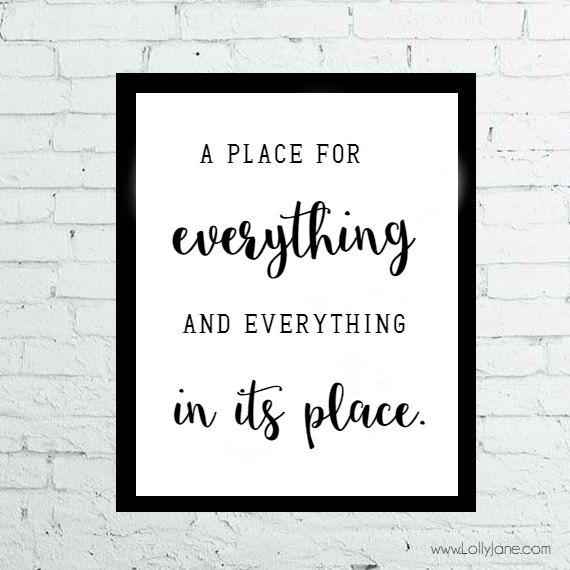In all my 18+ years of organizing people’s homes and offices, I don’t think there has been a project that hasn’t involved decluttering a closet or a drawer. In fact, the starting place for me on most organizing projects is to look at what is stored in drawers and behind doors.
Drawers and doors are excellent places to build systems. But there is a tendency for humans to shove items they don’t know what to do with into those places. As long as you can close the drawer, or shut the door the item has a “home”.
Or so you think.
When random items get put into a drawer or a closet whose intention at first is specific (i.e. all linens, all utensils, all t-shirts) it muddies the water. It clouds the system and welcomes in the infamous clutter.
Clutter is all the stuff you have that doesn’t have a home that is in the wrong spot. Sometimes that home is the trash. Clutter happens when a logical home isn’t created for the things that you let into your space. It also happens when you have too much of any one item. A drawer for your sweaters is a great home. A drawer for so many sweaters that the drawer is stuffed and can barely close is a signal that you have too much.
“Too much” creates overwhelm and confusion. And that usually creates…you guessed it – more clutter. When you can’t close a drawer you are more likely to put things in any open space or on any flat surface you can find. A bed, a desktop, a counter, the floor – these are all flat surfaces that should never be considered a viable home.
Cluttered, stuffed, overwhelmed spaces are a clear indication that it is time to de-clutter.
No one I know {other than me of course} loves the process of de-cluttering. It involves decision-making, and questioning whether what you have is needed, liked or used. But it is one of the most important things to do in order to create a good, logical, sustainable home for your things.
Creating a logical home means you honor the limits of your space and choose a home that allows you to easily see what you have and find what you need – without stress and frustration.
Create a clear home for things, and your space will follow suit.
Having a home for everything you own is the answer to things feeling organized. Being specific in where the best home is, and honoring that home, is the answer to you staying organized forever.

I want you to feel more organized, and lighter in your space. I know that addressing what you put behind doors and in drawers is a great start as they are areas that have a high propensity to collect clutter. Try these three quick de-cluttering projects to get a good jump start to better organization in your space, and lightness in your life.
Three De-cluttering Projects
1. The linen closet.
Having a clear vision for the purpose of the linen closet – a.k.a. how and for what you see the space being used – is key here. Having clarity for the space will means you are more likely to avoid just shoving things on any shelf. You might use the linen closet solely for linens and towels. Or if the space allows you might use it for spare toiletries, travel supplies and first aid.
The process: Empty the entire closet and group your like items together. This way you can see what is in the closet and make a better determination on whether what is in there fits the vision of the space. If it doesn’t fit the vision you won’t be putting it back. Once you have your piles of like-items do a purge and let go of what is old, tattered, not-liked or not needed. Contain items like first aid supplies, toiletries, dental hygiene, etc., using clear shoe bins. They are stackable so they save space, and they are one of my favorite supplies for building systems – especially in the closet. Once you have sorted, purged and contained you can put things back in the space. Check out this video of me organizing my linen closet for some inspiration to tackle your own.
2. The utility drawer.
This drawer should not be confused with your “junk” drawer – which actually shouldn’t be in the house at all. A junk drawer says that what is inside is, well…junk. A utility drawer tells you that what you are storing are things you use. Having clarity on the purpose of the drawer applies here as well – perhaps more importantly. A drawer is the best friend of small, miscellaneous things you have no idea what to do with. And because it becomes the catch-all it tends to get cluttered quickly.
The process: In order to be able to separate different items that are all under the umbrella of “utility” it is a good idea to get a drawer organizer. Check out The Container Store or Staples for variations that will fit your drawer best.
But before you buy, make sure you first purge, and then group your like items together. Purging what you don’t need, or what doesn’t belong, allows you to see more clearly what does belong. Putting the like-items together will give you an idea of how divided your drawer organizer should be. If you really want to stay organized, you will make sure that each compartment has a specific function. You will have a specific place for a tape dispenser, pencils and pens, car keys, post it notes, etc. If you stick to that kind of specificity you will be less likely to let clutter in.
The process of emptying the drawer, sorting and purging is something you could do every few months to keep yourself on top of what might have slipped in.
3. Sock drawer
The key to tackling any big organizing project whether it be all of your clothes, or the whole kitchen, is to bite off small pieces of the whole. A sock drawer in the bedroom – like a utility drawer in the kitchen – is a perfect small piece that can yield a great sense of instant gratification. It can also be a great catalyst for purging the rest of your clothes and closet.
The process: Empty out onto the bed or another clear surface the contents of your sock drawer. The goal is to sort through every kind of sock. Purge what you don’t like or use, what has holes or is old. Then do the same process of grouping the like items. This way you can see, for instance, how many athletic socks vs dress socks you have. You might consider purging even more once you see how many of one category you have.
When it comes to containing socks there are a few ways you can do this. In my opinion one way is not better than any other way. How you contain should be based on your preference – for how you wish to see things. I divide my drawer in half (you could use a supply like this) and put all athletic socks on the front because I use those more than the dress socks that are in the back. Some clients I have worked with prefer to have a container for each pair of socks (you could use a supply like this). For sure this is a great way to set a boundary for the space and in turn, limit how much you save.
A little caveat about how to contain your socks
According to Marie Kondo you should roll your socks when you contain them. It is a great way to see clearly what you have. And to be clear, I do not think storing them inside of each other in a ball (like I do) is wrong. Whatever feels good to you is good enough.
When a system feels good, you will use it.
When you use it, you stay organized.
_________________
Watch and learn more!





[…] This task can and should actually be done every month solely because so many unnecessary things end up there. The spare parts of a project you aren’t even finishing, spare change, extra keys (where did they come from?), and excess paper/pens/paperclips galore all gather and clutter the space. And over time, it becomes a chaotic mess you don’t even want to open. The more often you do a quick declutter of this space, the easier it is to keep in shape. Start now in fall. And put it on your calendar to give it another once over in a month. {As an aside note: I recommend you start calling this a utility drawer since what I assume you are storing inside is, in fact, being used. If you call it a “junk” drawer that is what you are more than likely to store in it.} […]